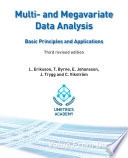To understand the world around us, as well as ourselves, we need to measure many things, many variables, many properties of the systems and processes we investigate. Hence, data collected in science, technology, and almost everywhere else are multivariate, a data table with multiple variables measured on multiple observations (cases, samples, items, process time points, experiments). This book describes a remarkably simple minimalistic and practical approach to the analysis of data tables (multivariate data). The approach is based on projection methods, which are PCA (principal components analysis), and PLS (projection to latent structures) and the book shows how this works in science and technology for a wide variety of applications. In particular, it is shown how the great information content in well collected multivariate data can be expressed in terms of simple but illuminating plots, facilitating the understanding and interpretation of the data. The projection approach applies to a variety of data-analytical objectives, i.e., (i) summarizing and visualizing a data set, (ii) multivariate classification and discriminant analysis, and (iii) finding quantitative relationships among the variables. This works with any shape of data table, with many or few variables (columns), many or few observations (rows), and complete or incomplete data tables (missing data). In particular, projections handle data matrices with more variables than observations very well, and the data can be noisy and highly collinear. Authors: The five authors are all connected to the Umetrics company (www.umetrics.com) which has developed and sold software for multivariate analysis since 1987, as well as supports customers with training and consultations. Umetrics' customers include most large and medium sized companies in the pharmaceutical, biopharm, chemical, and semiconductor sectors.
Åtkomstkoder och digitalt tilläggsmaterial garanteras inte med begagnade böcker









![Deep Learning Architectures [Elektronisk resurs]; Ovidiu Calin; 2020](/images/format:webp/size:256:0/quality:100/asset/book-cover/deep-learning-architectures-elektronisk-resurs-9783030367206)











